
A | B | C | D | E | F | G | H | CH | I | J | K | L | M | N | O | P | Q | R | S | T | U | V | W | X | Y | Z | 0 | 1 | 2 | 3 | 4 | 5 | 6 | 7 | 8 | 9
| African wild dog | |
|---|---|

| |
| African wild dog in South Africa | |
| Scientific classification | |
| Domain: | Eukaryota |
| Kingdom: | Animalia |
| Phylum: | Chordata |
| Class: | Mammalia |
| Order: | Carnivora |
| Family: | Canidae |
| Subfamily: | Caninae |
| Tribe: | Canini |
| Genus: | Lycaon |
| Species: | L. pictus
|
| Binomial name | |
| Lycaon pictus | |

| |
| African wild dog range according to the IUCN.
Extant (resident)
Probably extant (resident)
| |
The African wild dog (Lycaon pictus), also known as the painted dog or Cape hunting dog, is a wild canine native to sub-Saharan Africa. It is the largest wild canine in Africa, and the only extant member of the genus Lycaon, which is distinguished from Canis by dentition highly specialised for a hypercarnivorous diet and by a lack of dewclaws.
It is estimated that there are around 6,600 adults (including 1,400 mature individuals) living in 39 subpopulations, all threatened by habitat fragmentation, human persecution and outbreaks of disease. As the largest subpopulation probably consists of fewer than 250 individuals, the African wild dog has been listed as endangered on the IUCN Red List since 1990.[2]
The species is a specialised diurnal hunter of terrestrial ungulates, which it captures by using its stamina and cooperative hunting to exhaust them. Its natural competitors are lions and spotted hyenas: the former will kill the dogs where possible whilst the latter are frequent kleptoparasites.[4] Like other canids, the African wild dog regurgitates food for its young but also extends this action to adults as a central part of the pack's social unit.[5][4][6] The young have the privilege of feeding first on carcasses.
The African wild dog has been revered in several hunter-gatherer societies, particularly those of the San people and Prehistoric Egypt.
Etymology and naming
The English language has several names for the African wild dog, including African hunting dog, Cape hunting dog,[7] painted hunting dog,[8] painted dog,[9] painted wolf,[10] and painted lycaon.[11] Though the name African wild dog is widely used,[12] 'wild dog' is thought by conservation groups to have negative connotations that could be detrimental to its image; one organisation promotes the name 'painted wolf',[13][14][15] whilst the name 'painted dog' has been found to be the most likely to counteract negative perceptions.[16]
Taxonomic and evolutionary history
Taxonomy
| Phylogenetic tree of the wolf-like canids with timing in millions of years[a] |
The earliest written reference for the species appears to be from Oppian, who wrote of the thoa, a hybrid between the wolf and leopard, which resembles the former in shape and the latter in colour. Solinus's Collea rerum memorabilium from the third century AD describes a multicoloured wolf-like animal with a mane native to Ethiopia.[11]
The African wild dog was scientifically described in 1820 by Coenraad Jacob Temminck after examining a specimen from the coast of Mozambique. He named the animal Hyaena picta, erroneously classifying it as a species of hyena. It was later recognised as a canid by Joshua Brookes in 1827 and renamed Lycaon tricolor. The root word of Lycaon is the Greek λυκαίος (lykaios), meaning ‘wolf-like’. The specific epithet pictus (Latin for ‘painted’), which derived from the original picta, was later returned to it, in conformity with the International Rules on Taxonomic Nomenclature.[17]
Paleontologist George G. Simpson placed the African wild dog, the dhole and the bush dog together in the subfamily Simocyoninae on the basis of all three species having similarly trenchant carnassials. This grouping was disputed by Juliet Clutton-Brock, who argued that other than dentition too many differences exist among the three species to warrant classifying them in a single subfamily.[18]
Evolution

The African wild dog possesses the most specialized adaptations among the canids for coat colour and diet and for pursuing its prey through its cursorial (running) ability. It has a graceful skeleton, and the loss of the first digit on its forefeet increases its stride and speed. This adaptation allows it to pursue prey across open terrain for long distances. The teeth are generally carnassial-shaped and its premolars are the largest relative to body size of any living carnivoran with the exception of the spotted hyena. On the lower carnassials (first lower molars), the talonid has evolved to become a cutting blade for flesh-slicing, with a reduction or loss of the post-carnassial molars. This adaptation also occurs in the two other hypercarnivorous canids – the dhole and the bush dog. The African wild dog exhibits one of the most varied coat colours among mammals. Individuals differ in patterns and colours, indicating a diversity of the underlying genes. The purpose of these coat patterns may be an adaptation for communication, concealment or temperature regulation. In 2019 a study indicated that the lycaon lineage diverged from Cuon and Canis 1.7 million years ago through this suite of adaptations, and these occurred at the same time as large ungulates (its prey) diversified. The findings also suggest that the African wild dog is largely isolated from gene transfer with other canid species.[19]
The oldest African wild dog fossil dates back to 200,000 years ago and was found in HaYonim Cave, Israel.[20][1] The evolution of the African wild dog is poorly understood owing to the scarcity of fossil finds. Some authors consider the extinct Canis subgenus Xenocyon as ancestral to both the genus Lycaon and the genus Cuon,[21][22][23][24]: p149 which lived throughout Eurasia and Africa from the Early Pleistocene to the early Middle Pleistocene. Others propose that Xenocyon should be reclassified as Lycaon.[1] The species Canis (Xenocyon) falconeri shared the African wild dog's absent first metacarpal (dewclaw), though its dentition was still relatively unspecialised.[1] This connection was rejected by one author because C. (X.) falconeri's lack of the first metacarpal is a poor indication of phylogenetic closeness to the African wild dog, and the dentition was too different to imply ancestry.[25]
Another ancestral candidate is the Plio-Pleistocene Lycaon sekowei of South Africa on the basis of distinct accessory cusps on its premolars and anterior accessory cuspids on its lower premolars. These adaptions are found only in Lycaon among living canids, which shows the same adaptations to a hypercarnivorous diet. L. sekowei had not yet lost the first metacarpal absent in L. pictus and was more robust than the modern species, having 10% larger teeth.[25]
Admixture with the dhole
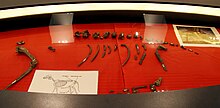
The African wild dog has 78 chromosomes, the same number as those of species in the genus Canis.[26] In 2018 whole genome sequencing was used to compare the dhole (Cuon alpinus) with the African wild dog. There was strong evidence of ancient genetic admixture between the two species. Today their ranges are remote from each other; however during the Pleistocene era the dhole could be found as far west as Europe. The study proposes that the dhole's distribution may have once included the Middle East, from where it may have admixed with the African wild dog in North Africa. However there is no evidence of the dhole having existed in the Middle East or North Africa.[27]
Subspecies
As of 2005[update], five subspecies are recognised by MSW3:[28]
| Subspecies | Description | Synonyms |
|---|---|---|
| Cape wild dog L. p. pictus Temminck, 1820 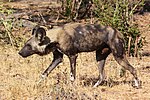
|
The nominate subspecies is also the largest, weighing 20–25 kg (44–55 lb).[29] It is much more colourful than the East African wild dog,[29] although even within this single subspecies there are geographic variations in coat colour: specimens inhabiting the Cape are characterised by the large amount of orange-yellow fur overlapping the black, the partially yellow backs of the ears, the mostly yellow underparts and a number of whitish hairs on the throat mane. Those in Mozambique are distinguished by the almost equal development of yellow and black on both the upper and underparts of the body, as well as having less white fur than the Cape form.[30] | cacondae (Matschie, 1915), fuchsi (Matschie, 1915), gobabis (Matschie, 1915), krebsi (Matschie, 1915), lalandei (Matschie, 1915), tricolor (Brookes, 1827), typicus (A. Smith, 1833), venatica (Burchell, 1822), windhorni (Matschie, 1915), zuluensis (Thomas, 1904) |
| East African wild dog L. p. lupinus Thomas, 1902 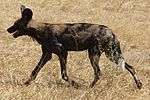
|
This subspecies is distinguished by its very dark coat with very little yellow.[30] | dieseneri (Matschie, 1915), gansseri (Matschie, 1915), hennigi (Matschie, 1915), huebneri (Matschie, 1915), kondoae (Matschie, 1915), lademanni (Matschie, 1915), langheldi (Matschie, 1915), prageri (Matschie, 1912), richteri (Matschie, 1915), ruwanae (Matschie, 1915), ssongaeae (Matschie, 1915), stierlingi (Matschie, 1915), styxi (Matschie, 1915), wintgensi (Matschie, 1915) |
| Somali wild dog L. p. somalicus Thomas, 1904 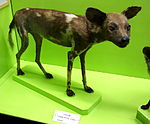
|
This subspecies is smaller than the East African wild dog, has shorter and coarser fur and has a weaker dentition. Its colour closely approaches that of the Cape wild dog, with the yellow parts being buff.[30] | luchsingeri (Matschie, 1915), matschie (Matschie, 1915), rüppelli (Matschie, 1915), takanus (Matschie, 1915), zedlitzi (Matschie, 1915) |
| Chadian wild dog L. p. sharicus Thomas and Wroughton, 1907 |
Brightly coloured with very short 15 mm (0.6 in) hair. Brain case is fuller than L. p. pictus.[31] | ebermaieri (Matschie, 1915) |
| West African wild dog L. p. manguensis Matschie, 1915 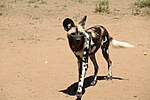
|
The West African wild dog used to be widespread from western to central Africa, from Senegal to Nigeria. Now only two subpopulations survive: one in the Niokolo-Koba National Park of Senegal and the other in the W National Park of Benin, Burkina Faso and Niger.[2][32] It is estimated that 70 adult individuals are left in the wild.[33] | mischlichi (Matschie, 1915) |
Although the species is genetically diverse, these subspecific designations are not universally accepted. East African and Southern African wild dog populations were once thought to be genetically distinct, based on a small number of samples. More recent studies with a larger number of samples showed that extensive intermixing has occurred between East African and Southern African populations in the past. Some unique nuclear and mitochondrial alleles are found in Southern African and northeastern African populations, with a transition zone encompassing Botswana, Zimbabwe and southeastern Tanzania between the two. The West African wild dog population may possess a unique haplotype, thus possibly constituting a truly distinct subspecies.[34] The original Serengeti and Maasai Mara population of painted dogs is known to have possessed a unique genotype, but these genotypes may be extinct.[35]
Description


The African wild dog is the bulkiest and most solidly built of African canids.[36] The species stands 60 to 75 cm (24 to 30 in) at the shoulders, measures 71 to 112 cm (28 to 44 in) in head-and-body length and has a tail length of 29 to 41 cm (11 to 16 in). Adults have a weight range of 18 to 36 kg (40 to 79 lb). On average, dogs from East Africa weigh around 20–25 kg (44–55 lb). By body mass, they are only outsized amongst other extant canids by the gray wolf species complex.[29][37][38] Females are usually 3–7% smaller than males. Compared to members of the genus Canis, the African wild dog is comparatively lean and tall, with outsized ears and lacking dewclaws. The middle two toepads are usually fused. Its dentition differs from that of Canis by the degeneration of the last lower molar, the narrowness of the canines and proportionately large premolars, which are the largest relative to body size of any carnivore other than hyenas.[39] The heel of the lower carnassial M1 is crested with a single, blade-like cusp, which enhances the shearing capacity of the teeth, thus the speed at which prey can be consumed. This feature, termed "trenchant heel", is shared with two other canids: the Asian dhole and the South American bush dog.[7] The skull is relatively shorter and broader than those of other canids.[36]
The fur of the African wild dog differs significantly from that of other canids, consisting entirely of stiff bristle-hairs with no underfur.[36] Adults gradually lose their fur as it ages, with older individuals being almost naked.[40] Colour variation is extreme, and may serve in visual identification, as African wild dogs can recognise each other at distances of 50–100 m (160–330 ft).[39] Some geographic variation is seen in coat colour, with northeastern African specimens tending to be predominantly black with small white and yellow patches, while southern African ones are more brightly coloured, sporting a mix of brown, black and white coats.[7] Much of the species' coat patterning occurs on the trunk and legs. Little variation in facial markings occurs, with the muzzle being black, gradually shading into brown on the cheeks and forehead. A black line extends up the forehead, turning blackish-brown on the back of the ears. A few specimens sport a brown teardrop-shaped mark below the eyes. The back of the head and neck are either brown or yellow. A white patch occasionally occurs behind the fore legs, with some specimens having completely white fore legs, chests and throats. The tail is usually white at the tip, black in the middle and brown at the base. Some specimens lack the white tip entirely, or may have black fur below the white tip. These coat patterns can be asymmetrical, with the left side of the body often having different markings from the right.[39]
Distribution and habitat
The African wild dog occurs foremost in Southern and East Africa.[2] It is rare in North Africa and mostly absent in West Africa, with the only potentially viable population occurring in Senegal's Niokolo-Koba National Park. It is occasionally sighted in other parts of Senegal, Guinea and Mali. Its distribution is patchy in East Africa.[41] It inhabits mostly savannas and arid zones, generally avoiding forested areas.[29] This preference is likely linked to its hunting habits, which require open areas that do not obstruct vision or impede pursuit.[36] It travels through scrubland, woodland and montane areas in pursuit of prey. A forest-dwelling population has been identified in the Harenna Forest, a wet montane forest up to an elevation of 2,400 m (7,900 ft) in the Bale Mountains of Ethiopia.[42] At least one record exists of a pack being sighted on the summit of Mount Kilimanjaro.[29] In Zimbabwe, it has been recorded at the elevation of 1,800 m (5,900 ft).[12] In Ethiopia, several packs were sighted at elevations of 1,900 to 2,800 m (6,200 to 9,200 ft), and a dead individual was found in June 1995 at 4,050 m (13,290 ft) on the Sanetti Plateau.[43] A stable population comprising more than 370 individuals is present in Kruger National Park.[44]
Behaviour and ecology
Social and reproductive behaviour


The African wild dog have strong social bonds, stronger than those of sympatric lions and spotted hyenas; thus, solitary living and hunting are extremely rare in the species.[45] It lives in permanent packs consisting of two to 27 adults and yearling pups. The typical pack size in the Kruger National Park and the Maasai Mara is four or five adults, while packs in Moremi and Selous Game Reserves contain eight or nine. However, larger packs have been observed and temporary aggregations of hundreds of individuals may have gathered in response to the seasonal migration of vast springbok herds in Southern Africa.[46] Males and females have separate dominance hierarchies, with the latter usually being led by the oldest female. Males may be led by the oldest male, but these can be supplanted by younger specimens; thus, some packs may contain elderly male former pack leaders. The dominant pair typically monopolises breeding.[39] The species differs from most other social carnivorans in that males remain in the natal pack, while females disperse (a pattern also found in primates such as gorillas, chimpanzees, and red colobuses). Furthermore, males in any given pack tend to outnumber females 3:1.[29] Dispersing females join other packs and evict some of the resident females related to the other pack members, thus preventing inbreeding and allowing the evicted individuals to find new packs of their own and breed.[39] Males rarely disperse, and when they do, they are invariably rejected by other packs already containing males.[29] Although arguably the most social canid, the species lacks the elaborate facial expressions and body language found in the gray wolf, likely because of the African wild dog's less hierarchical social structure. Furthermore, while elaborate facial expressions are important for wolves in re-establishing bonds after long periods of separation from their family groups, they are not as necessary to African wild dogs, which remain together for much longer periods.[18] The species does have an extensive vocal repertoire consisting of twittering, whining, yelping, squealing, whispering, barking, growling, gurling, rumbling, moaning and hooing.[47]
African wild dog populations in East Africa appear to have no fixed breeding season, whereas those in Southern Africa usually breed during the April–July period.[45] During estrus, the female is closely accompanied by a single male, which keeps other members of the same sex at bay.[29] The estrus period can last as long as 20 days.[48] The copulatory tie characteristic of mating in most canids has been reported to be absent[49] or very brief (less than one minute)[50] in African wild dog, possibly an adaptation to the prevalence of larger predators in its environment.[51] The gestation period lasts 69–73 days, with the interval between each pregnancy being 12–14 months typically. The African wild dog produces more pups than any other canid, with litters containing around six to 16 pups, with an average of 10, thus indicating that a single female can produce enough young to form a new pack every year. Because the amount of food necessary to feed more than two litters would be impossible to acquire by the average pack, breeding is strictly limited to the dominant female, which may kill the pups of subordinates. After giving birth, the mother stays close to the pups in the den, while the rest of the pack hunts. She typically drives away pack members approaching the pups until the latter are old enough to eat solid food at three to four weeks of age. The pups leave the den around the age of three weeks and are suckled outside. The pups are weaned at the age of five weeks, when they are fed regurgitated meat by the other pack members. By seven weeks, the pups begin to take on an adult appearance, with noticeable lengthening in the legs, muzzle, and ears. Once the pups reach the age of eight to 10 weeks, the pack abandons the den and the young follow the adults during hunts. The youngest pack members are permitted to eat first on kills, a privilege which ends once they become yearlings.[29] African wild dogs have an average lifespan of about 10 to 11 years in the wild.[52]
When separated from the pack, an African wild dog becomes depressed and can die as a result of broken heart syndrome.[53][54]
Male/female ratio
Packs of African wild dogs have a high ratio of males to females. This is a consequence of the males mostly staying with the pack whilst female offspring disperse and is supported by a changing sex-ratio in consecutive litters. Those born to maiden females contain a higher proportion of males, second litters are half and half and subsequent litters biased towards females with this trend increasing as females get older. As a result, the earlier litters provide stable hunters whilst the higher ratio of dispersals amongst the females stops a pack from getting too big.[5]
Sneeze communication and ‘voting’

Populations in the Okavango Delta have been observed ‘rallying’ before setting out to hunt. Not every rally results in a departure, but departure becomes more likely when more individual dogs ‘sneeze’. These sneezes are characterized by a short, sharp exhale through the nostrils.[55] When members of dominant mating pairs sneeze first, the group is much more likely to depart. If a dominant dog initiates, around three sneezes guarantee departure. When less dominant dogs sneeze first, if enough others also sneeze (about 10), then the group will go hunting. Researchers assert that wild dogs in Botswana "use a specific vocalization (the sneeze) along with a variable quorum response mechanism in the decision-making process ".[55]
Inbreeding avoidance
Because the African wild dog largely exists in fragmented, small populations, its existence is endangered. Inbreeding avoidance by mate selection is a characteristic of the species and has important potential consequences for population persistence.[56] Inbreeding is rare within natal packs. Inbreeding may have been selected against evolutionarily because it leads to the expression of recessive deleterious alleles.[57] Computer simulations indicate that all populations continuing to avoid incestuous mating will become extinct within 100 years due to the unavailability of unrelated mates.[56] Thus, the impact of reduced numbers of suitable unrelated mates will likely have a severe demographic impact on the future viability of small wild dog populations.[56]
Zdroj:https://en.wikipedia.org?pojem=African_hunting_dog
Text je dostupný za podmienok Creative Commons Attribution/Share-Alike License 3.0 Unported; prípadne za ďalších podmienok. Podrobnejšie informácie nájdete na stránke Podmienky použitia.
Antropológia
Aplikované vedy
Bibliometria
Dejiny vedy
Encyklopédie
Filozofia vedy
Forenzné vedy
Humanitné vedy
Knižničná veda
Kryogenika
Kryptológia
Kulturológia
Literárna veda
Medzidisciplinárne oblasti
Metódy kvantitatívnej analýzy
Metavedy
Metodika
Text je dostupný za podmienok Creative
Commons Attribution/Share-Alike License 3.0 Unported; prípadne za ďalších
podmienok.
Podrobnejšie informácie nájdete na stránke Podmienky
použitia.
www.astronomia.sk | www.biologia.sk | www.botanika.sk | www.dejiny.sk | www.economy.sk | www.elektrotechnika.sk | www.estetika.sk | www.farmakologia.sk | www.filozofia.sk | Fyzika | www.futurologia.sk | www.genetika.sk | www.chemia.sk | www.lingvistika.sk | www.politologia.sk | www.psychologia.sk | www.sexuologia.sk | www.sociologia.sk | www.veda.sk I www.zoologia.sk

